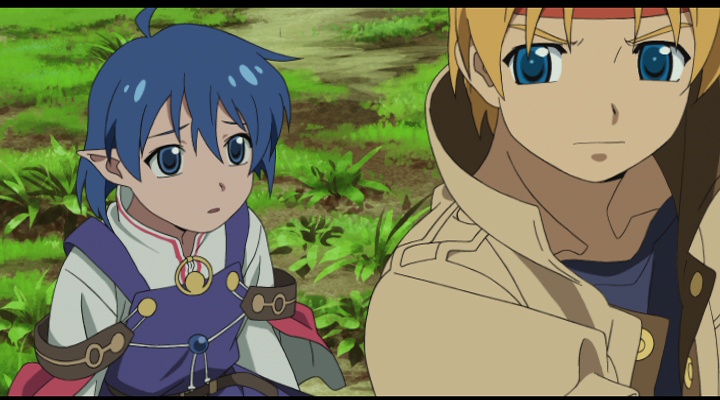Star Ocean: Second Evolution is an enhanced remake of developer Tri-Ace's Star Ocean: The Second Story, a popular PlayStation role-playing game. It shares much with First Departure, a recent remake of the original Star Ocean, highlighted by incredibly striking anime sequences courtesy of Production I.G., full voicing, and even an updated, smoother translation. The two games look and feel nearly identical, but while First Departure suffered from gruesome backtracking, Second Evolution frees itself from the constant barrage of pointless globe-trotting by focusing on engaging gameplay and a cohesive plot.

The game casts you as either Claude, a reluctant Federation ensign following in the footsteps of his powerful father, or Rena, a young girl who is desperately trying to locate her parents. Their fates intertwine as Claude accidentally sends himself through an interstellar gateway and awakens near Rena's village, where the locals are far too eager to adopt him as their prophesied hero. The story branches between the two characters for a more interesting twist, and while you'll observe only slight changes in the overall plot depending on your choice, the difference is enough to encourage a second play-through to flesh out both characters and to access all anime segments. There are numerous superfluous conversations between characters ("private action scenes"), but aside from giving your ally friendship levels a slight boost, these scenes won't do much for you. Nevertheless, the story and characters are all well done, and make this grand adventure one worth taking
You spend most of your time traversing a 3D world map that's just as bland as First Departure's and also suffers from occasional pop-up, which you'll spy whenever huge landmasses suddenly appear at your feet. It's a nuisance, but the convenient minimap and its excellent zoom feature help you navigate with ease. The incredibly mundane and exhausting backtracking from First Departure is utterly absent in Second Evolution, and the game is better for it; this equates to very little time wasted on the field defeating underleveled foes en route to a town you've already visited, which is refreshing. The standard quests still culminate in fetching items or talking to a famed non-player character the next town over, but more interesting side quests have also been implemented for optional characters and keep the adventure lively.
Battles are randomly generated real-time affairs that occur on a barren 3D battlefield. They're usually fast-paced and place you in control of the party leader while the adequate AI effectively manages your teammates, supporting your attacks with dependable melee allies and attentive spellcasters. You can adjust party tactics if an ally is giving you trouble, or assume direct control of the offender even in the midst of battle, a helpful feature that grants you immediate tactical control over any party member. Battles typically involve using overpowered spells and newly added three-hit combos to succeed, but the game avoids becoming just another button masher by offering progressively more challenging enemies, which encourages more strategic play. Unfortunately, tougher enemies and lengthier battles make casting somewhat annoying because your party members are frozen for the duration of any spells; the simple option to either shorten or skip these animations is sorely missing. The targeting system maintains a free-roaming option that gives you full view of your surroundings, but for the most part, autotargeting--when your reticle latches onto the nearest opponent--operates quite smoothly unless you happen to get surrounded by enemies, in which case the reticle bounces between them in confusion.
Extensive crafting and skill systems provide fun alternatives to straightforward monster hunting and questing. You can create items, write articles, cook delicious food, or even take up sculpting for quick cash. Crafting is an interesting activity, and serious item collectors will find plenty of depth here. Fortunately, it is unnecessary for completing the game, as you'll find it very easy to acquire excellent gear just by looting random chests. The skill system is even more exhaustive, enabling you to customize nearly every aspect of your favorite characters by awarding you skill points for leveling. These points can be spent on a full spectrum of abilities that can directly modify character stats, raise your skill points earned per level, increase or decrease your enemy encounter rate, and unlock a plethora of convenient specialties to make your travels easier. Mastering numerous skills and specialties with several characters will eventually unlock super specialties, which are unique skills that the entire party uses to pitch in to increase the success of a certain feat, such as book publishing.

Anime house Production I.G. has once again applied its creative talent to produce jaw-dropping anime sequences for a Star Ocean remake. A very impressive new opening and a new Japanese musical theme illustrate the game's most popular events and make for a special treat for fans. There are roughly 10 of these beautiful clips; however, some are a little short, and you'll have to thoroughly investigate every location to view them all. Despite these gorgeous sequences, the game often relies on the original's crude CG cutscenes for important segments, which somewhat cheapens key moments. The prerendered environments are highly detailed and feature numerous intricate touches, like sparkling streams, lush greenery, and even birds flying overhead. Character sprites now look sharper and complement the great anime segments, and while some character quips are overexaggerated, the voice acting is still a drastic improvement on Second Story's.
You can finish the main quest line in about 30 hours, but activating private action scenes, exploring the game's intimidating secret dungeon, crafting, and completing character quest lines can easily triple this amount. You can also unlock a difficulty option for additional play-throughs if you're interested in acquiring new party members and seeing events from the other main character's point of view. With strong replayability and a stunning presentation, Star Ocean: Second Evolution is a competent remake that offers a great opportunity for experiencing this PlayStation classic.